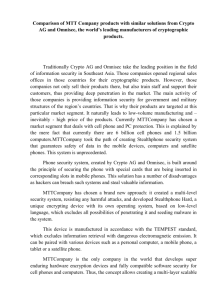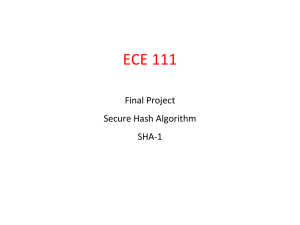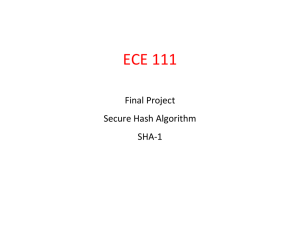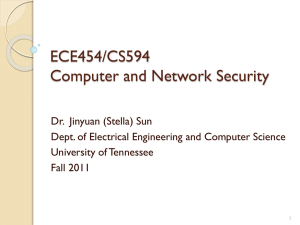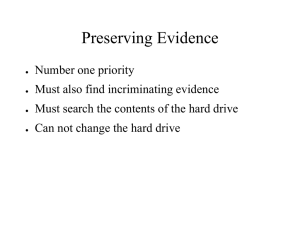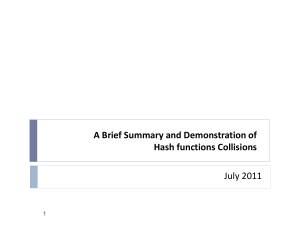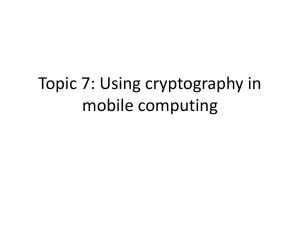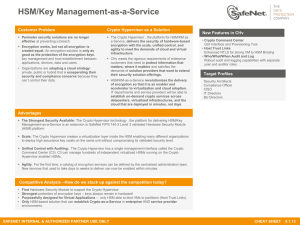Presentation - Turing Gateway to Mathematics
advertisement
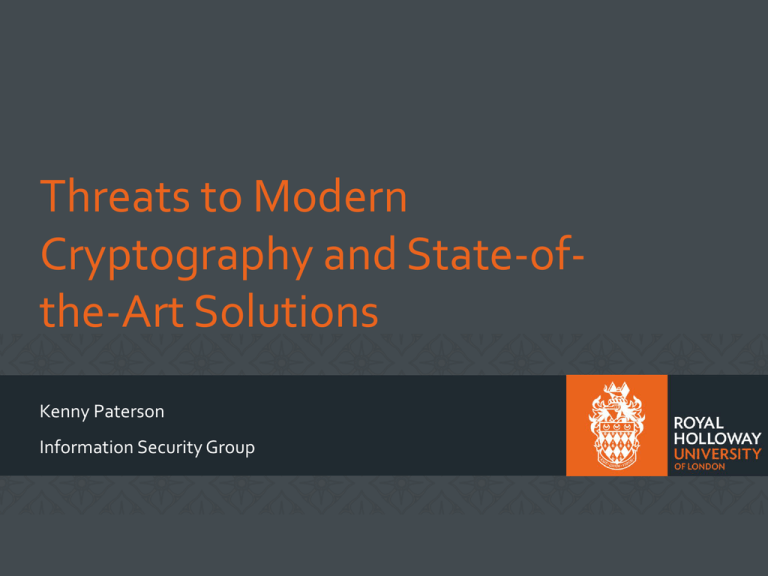
Threats to Modern
Cryptography and State-ofthe-Art Solutions
Kenny Paterson
Information Security Group
Living with the Threat of the
Crypt-Apocalypse
Kenny Paterson
Information Security Group
Crypto In Use
Relative to the number of primitives that have been
invented by academic cryptographers, the number that
are actually in use today is tiny.
Symmetric encryption, MACs, key derivation.
DHKE, signatures, public key encryption (mostly RSA PKCS#1
v1.5).
Almost all for secure comms, and a bit of secure storage.
Relatively small number of algorithms too.
RSA, a growing amount of ECC, lots of AES, SHA-1, surprising
amount of RC4.
3
Take Up of New Crypto
Adoption of new crypto is slow, for several reasons:
Lack of compelling applications that people/organisations actually
want/need.
Performance (e.g. FHE poster-child).
Lack of support in crypto libraries.
Patents and related uncertainty.
Slow pace of standardisation.
Almost all industrial crypto today is quite boring.
This does not mean to say it’s easy to get right.
4
Lifetime of a Hash Algorithm – MD5
1992: MD5 published – “MD4 with seatbelts”.
1993: First weaknesses in MD5 identified (den Boer and Bosselaers).
1996: Serious weaknesses discovered (Dobbertin).
2004: Collisions for full MD5 (Wang et al.)
… Massive effort to remove MD5 from codebases …
2009: Rogue certificates (=rather meaningful collisions) (Stevens et al.)
2012: Flame malware discovered, exploiting MD5 collisions in Microsoft
code-signing certs.
The process of fully eliminating MD5 is still on-going, 10 years after first
collisions were discovered.
5
Lifetime of a Hash Algorithm – SHA-1
1995: SHA-1 published (NIST, tweak of 1993 SHA-0 design)
1990s: (various attacks on SHA-0, validating switch to SHA-1)
2001: SHA-2 published by NIST.
2005: Collision attack for SHA-1, estimated at 263 hash operations (Wang et
al.).
2005 – now: various claims and counter-claims about improvements.
2006: NIST deprecates SHA-1 from 2010 by federal agencies for all new
applications requiring collision-resistance.
2013: Microsoft annonces SHA-1 deprecation from 2016 for new code
signing certs.
2014: Still no collisions, best estimate is 261 hash operations (Stevens).
2014: SHA-1 is still used pretty much everywhere.
6
Netcraft Survey – Uptake of SHA-2 post Heartbleed
7
Moore’s law for Quantum Computing?
http://en.wikipedia.org/wiki/Timeline_of_quantum_computing
1998: 2-qubit and 3-qubit NMR
2000: 5-qubit and 7-qubit NMR.
2001: The number 15 is factored!
2005: qbyte announced (8 qubits?)
2006: 12 qubits
2007: 28 qubits
2008: 128 qubits
(D-Wave)
2011: 14 qubits
But maybe this is the wrong way to look at things? (aka shifting the goalposts)
8
Other Ways to Look at Things
The threat of large-scale quantum computing is weakly analogous to the
threat of a break-through in SHA-1 collision finding.
Breakthrough might be imminent, but then again it might not.
Hard to quantify risk that it will happen, and hard to put time-frame on it.
Meaningful results would have substantial impact.
Smart people are working on it and have had a lot of research investment.
(There are different physical approaches being pursued.)
[On the other hand, maybe QC is a bit like fusion research?
Random conversations I’ve been party to:
“Large scale QC is a decade away”.
“Large scale QC is now just a matter of engineering”.]
9
The Coming Crypt-Apocalypse?
We don’t know if there will be a QC scale breakthrough or not.
If one comes, it would be fairly catastrophic – a Crypt-Apocalypse.
We would expect some warning of impending disaster.
But replacing crypto at scale takes decades.
And traffic captured now could be broken later, so it’s a problem now.
Serious people are starting to think seriously about the possibility.
10
Ways Forward?
More usefully:
Design new cryptosystems from scratch.
Lots of basic research needed.
20 years to deployment.
Improve existing cryptosystems.
Lattice-based, code-based, non-linear systems
of equations,…
Lots of basic research needed.
Possibly vulnerable to further advances in
quantum algorithms.
Develop formal theory for provable security
with quantum adversaries, understand what can
and cannot be proved.
Consider a world without any public key
cryptography?
Maybe there will be progress in quantum algorithms too.
11
A World Without Public Key Cryptography?
Known as Minicrypt in the complexity theory literature (Impaglazzio, 1995).
Basic tools: symmetric encryption (block ciphers), hash functions.
So what can be done with just these tools?
We can still build signature schemes (using only one-way functions).
Lamport signatures (1979) + hash trees.
Substantial research effort has gone into optimising constructions.
Not as efficient as, e.g. EC-DSA or RSA signatures, but just about usable.
But we don’t know how to do secure public key encryption, and we don’t
know how to do secure DHKE.
12
A World Without Public Key Cryptography
In fact, we frequently operate at vast scale and without PKC!
Quiz question:
There is a global system with more than 6 billion users that provides user
authentication and enables secure communications, but which does not
use any public key crypto. Name it.
Answer:
(aka GSM/UMTS/3g/4g/LTE).
13
Characteristics of 3GPP Systems
Use of hardware to store keys and perform sensitive crypto operations (SIM
in phone, HSM or similar in operator’s Authentication Centre).
800+ network operators, inter-operability (allowing roaming between home
and visited networks).
Standardisation (of algorithms for encryption and protocol for
authentication).
Key management is a significant cost.
Pre-shared key embedded in SIM during manufacture and copy given to operator.
Used for authentication and to derive encryption keys.
System is semi on-line, to get encryption keys to where they are needed.
We can do this!
14
Further Characteristics of 3GPP Systems
Particular trust relationships are put in place between subscribers and
operators.
Operators want to be able to bill subscribers accurately
authentication
Subscribers would like a modicum of privacy
confidentiality
(not always switched on, not end-to-end, legal intercept capability)
It’s a subscription-based and closed system.
Would not work for e-commerce, which is a “roll-up and use” open system.
15
Open Systems without PKC?
Challenge is to replace PKC in open systems.
Prototypical application: e-commerce, protected by SSL/TLS.
Characteristics and requirements:
No pre-arranged trust relationships or keys.
Customers (and credit card providers) want privacy against eavesdroppers.
Customers want to be able to verify identity of servers.
Security Meta-Theorem:
Any cryptographic problem can be solved by the introduction of
sufficiently many trusted third parties.
16
Applying the Meta-Theorem come the CryptApocalypse
Alice’s TTP
Please give me a
key to talk to Bob.
His TTP is
“Bob’s TTP”
“My client would like to talk to your client Bob.
Please give me a key and a key blob.”
Bob’s TTP
{ }Bob
{ }Bob
Who is your TTP?
My TTP is “Bob’s TTP”
{ }Bob
Low-tech 4-party protocol to establish keys for authentication and secure communications.
Can even integrate fairly smoothly with existing SSL/TLS PSK protocol flow.
Deployment would messy, expensive, hard, disruptive, but eminently possible given enough
motivation.
17
Applying the Meta-Theorem come the CryptApocalypse
Proposed “solution” has problems…
Client (Alice) needs trust relationship with TTP (who pays?).
Built-in key escrow facility.
Apply the Security Meta-Theorem again…
Users contract with multiple TTPs and use secret-sharing techniques.
Still weaker than truly escrow-free solutions based on PKC.
Proposed solution is also more “on-line” than existing PKC-based system.
But reality is that existing system becomes on-line as soon as practical, scalable
revocation mechanisms are considered.
OCSP!
Solution has obvious privacy issues.
But then so has SSL/TLS!
Research question: can these be addressed using only symmetric techniques?
18
Concluding Remarks
The Crypt-Apocalypse might be coming… or it might not.
It deserves serious consideration either way.
Post-quantum Public Key Crypto is one sensible response.
Thinking about redesign of Trust and Key Management
Infrastructures is another response.
Questions/Comments?
19

